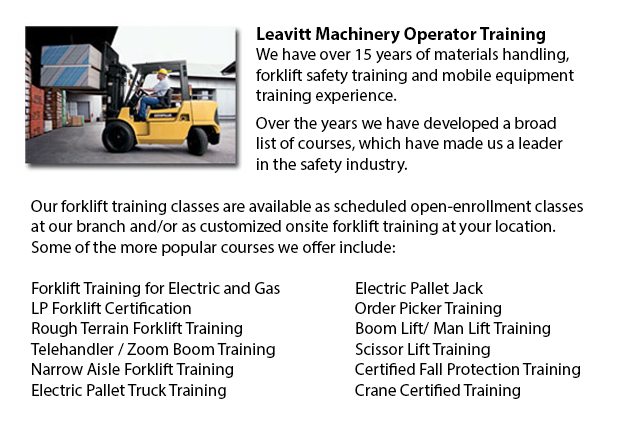
London Forklift Training Programs - If you are searching for a job as an operator of a forklift, our regulatory-compliant forklift training programs provide exceptional instruction in many types and styles of lift trucks, classes on pre-shift inspection, fuel types and handling of fuels, and safe utilization of a forklift. Practical, hands-on training helps individuals participating in obtaining essential operational skills. Course content consists of existing regulations governing the operation of forklifts. Our proven forklift programs are meant to provide training on these kinds of trucks: counterbalanced forklift, powered pallet trucks and narrow isle forklift.
How to Handle Loads Safely
When the forklift is in operation, do not lower or raise the forks. Loads must not extend higher than the backrest. This is because of the possibility of the load sliding back towards the operator. Inspect for overhead obstacles and make sure there is sufficient clearance before lifting a load. Stay away from overhead power lines. Once the load is lifted straight up, tilt it back slightly.
The lift truck is less steady when a load is in a raised position. Make sure that no one ever walks under the elevated fork. The operator should not leave the lift truck while the load is raised.
When handling pallets, forks should be high and level enough to go into the pallet and extend all the way below the load. The width of the forks should provide even distribution of weight.
Prior to loading or unloading the truck, set the brakes and chock the wheels. Floors need to be strong enough to support the weight of the forklift and the load combined. Fixed jacks could be installed in order to support a semi-trailer which is not coupled to a tractor. The entrance door height should clear the height of the forklift by a minimum of 5 cm. Edges of docks, rail cars and ramps should be marked and avoid them.
Do not stay in a forklift for long periods without proper ventilation. The interior of the truck must be well lighted and free of trash, loose objects and obstructions. Check for holes in the floor. The installation of nonslip material on the floor would help prevent slipping. Clear any obstacles from dockplates and docks and ensure surfaces are not oily or wet.
Lift trucks should not be used to push or tow other forklifts.
-
London Crane License
London Crane License - Crane operators ought to be "credentialed", that means they must possess a crane operator license or certification. Credentialing is considered a mandatory governmental requirement in order to practice as a crane operator. Obta... More -
London Heavy Equipment Operator Training
London Heavy Equipment Operator Training - Training facilities which offer quality standards in the industry and not just provide field performing tasks but added equipment training are highly sought after. Accredited schools provide students the kno... More -
Telehandler Training in London
Telescopic handlers usually referred to as telehandlers for short, are a very popular piece of heavy construction machinery. They are usually utilized in the agriculture and construction industries. These machines have maximum reaching capacity and c... More -
London Boom Lift Certification
London Boom Lift Certification - Elevated work platforms allow maintenance operations and work to be carried out at heights which could not be reached by any other means. Workers utilizing boom lifts and scissor lifts can learn how to safely operate... More -
London Fall Protection Ticket
London Fall Protection Ticket - Fall-related accidents are the number one reason of death within the construction industry. The potential for fall incidents really increases based upon the kind of work that is being completed within your workplace. T... More -
London Forklift Safety Training
London Forklift Safety Training - Anybody who wants to operate a lift truck should take a forklift safety training program to become a certified forklift truck operator. There are several ways to obtain forklift training. Programs are provided throug... More -
Operator Safety Training, Re-Qualification Training, In-House Instructor Training in London
Lift trucks are used in nearly all warehouse operations and in boat yards and in industrial construction sites. The reach feature of a forklift is a vital component used in various applications like for instance whenever a shelving system is being us... More -
London Boom Lift Safety Training
London Boom Lift Safey Training - Boom lifts are a type of elevated work platform or aerial lifting device that are commonly utilized in construction, industry, and warehousing. Boom lifts can be used in practically any surroundings due to their vers... More

Forklift Certification London
TOLL FREE: 1-888-254-6157
London, Ontario
forkliftcertificationlondon.com
Email Us
About Us


